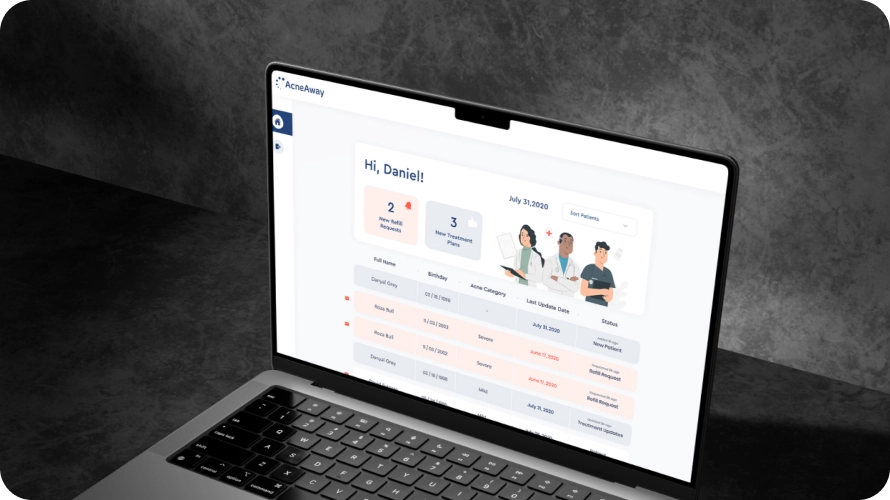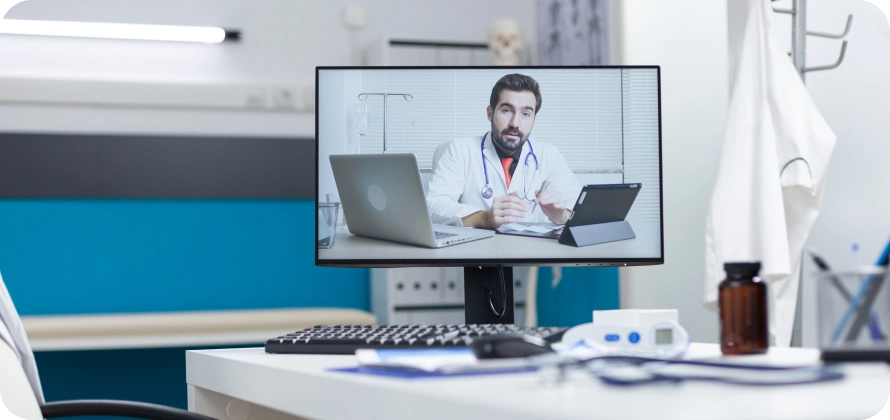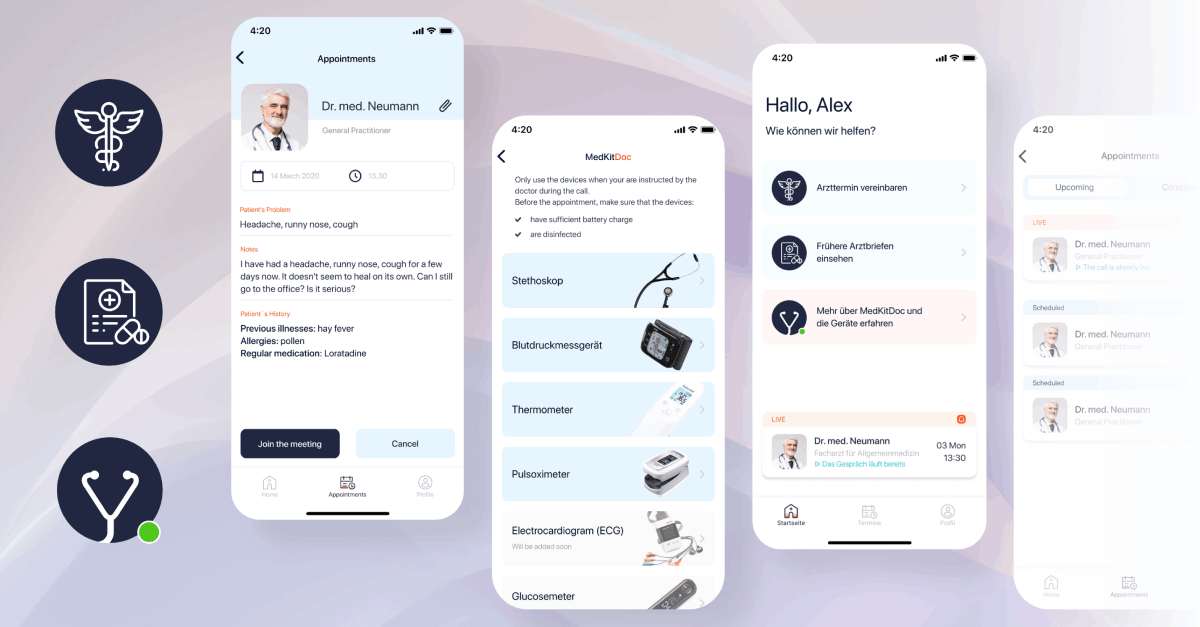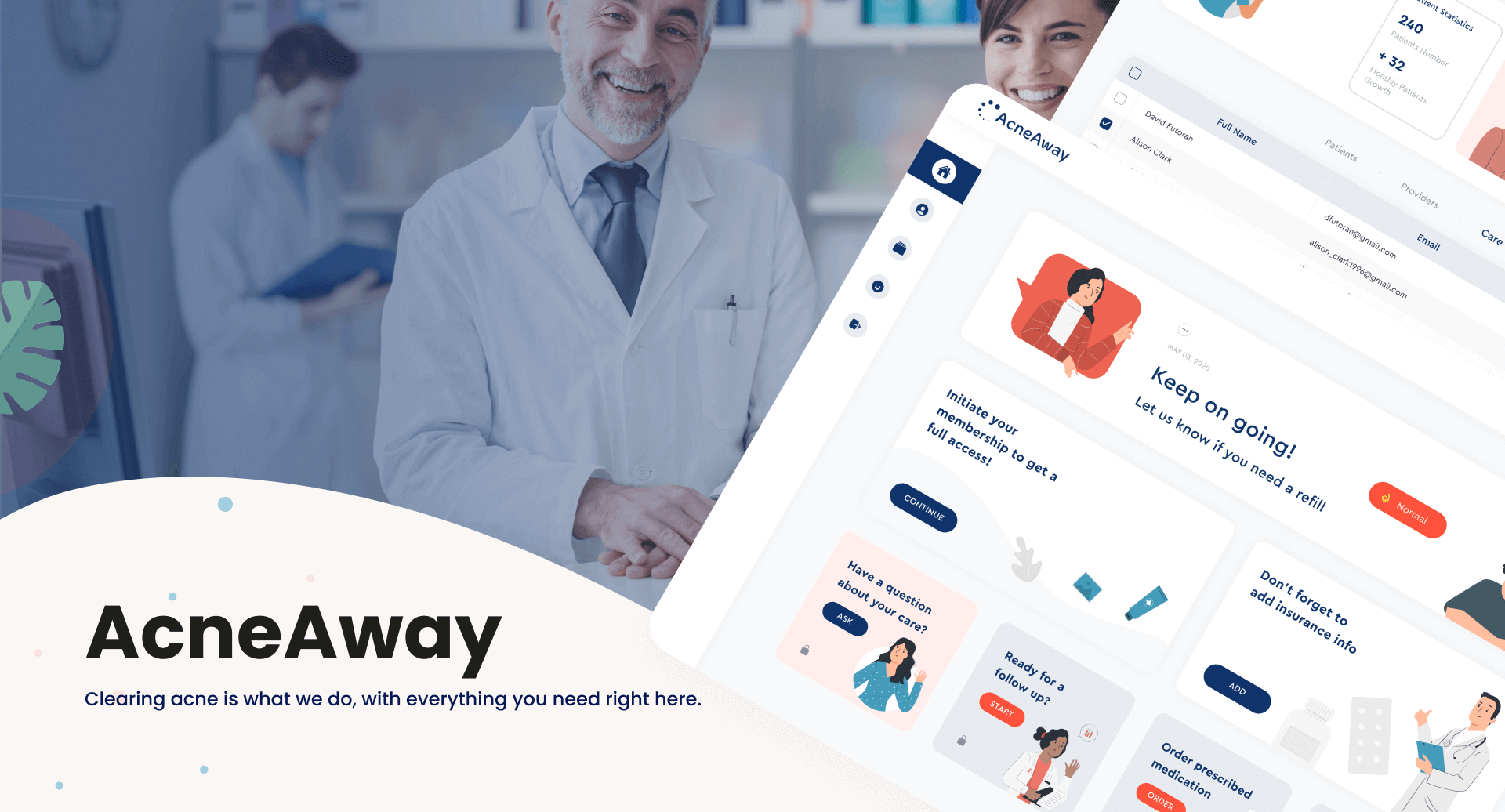Telemedicine software gained popularity during the COVID-19 pandemic in 2020. Because of the lockdown and hospital overload, remote doctor appointments became vital to healthcare. However, now that the pandemic is over, medical professionals realize the full potential of telehealth solutions, and teledermatology in particular.
Telemedicine has made dermatology care accessible, convenient, and affordable, reducing wait times and unnecessary in-person visits. Therefore, numerous healthcare providers are integrating teledermatology into their practices to enjoy the technology’s benefits. In this article, we look at the must-have features of teledermatology apps and best practices for their adoption.
 $114.98 billion
$114.98 billion
The global telemedicine technology market size was valued at $114.98 billion in 2023.
 $62.69 billion
$62.69 billion
The global teledermatology market is expected to exceed $62.69 billion by 2032.
 33.53%
33.53%
North America dominated the telemedicine market with a revenue share of 33.53% in 2023.
What is Teledermatology?
Teledermatology refers to the use of telecommunications technology (text messages, audio and video calls, and images) in dermatological care. Being a visually-dependent medical field, dermatology is well suited for remote supervision and support of healthcare professionals.
Telemedicine solutions in dermatology work best to examine and treat visible skin, hair, and nail conditions, including acne, rashes, psoriasis, eczema, allergic reactions, suspicious moles, etc.

Teledermatology is a safe, convenient, and cost-effective tool to supplement routine in-person dermatology appointments. It can be used to manage chronic conditions (eczema or atopic dermatitis) or follow-up visits of patients with conditions not requiring detailed examination (acne). In these situations, photos, videos, and descriptions may be sufficient to aid in diagnosis or medication counseling.
However, if a telemedicine appointment isn’t enough for proper examination and diagnosis, patients will need to come for an in-person appointment. During a telemedicine visit, doctors can identify a skin condition requiring an in-office follow-up for biopsy, test taking, treatment, or other procedures.
10 Must-Have Features for a Teledermatology App
-
1 Secure Video Conferencing
Quality telemedicine solutions can’t be imagined without reliable and HIPAA-compliant video conferencing features. The telemedicine app should provide robust video streaming, clear audio, high video quality, and consistent performance even in low-bandwidth environments.
However, to ensure effective communication, you also need to integrate other in-app communication methods, such as a chatbot, text messages, and audio calls.
-
2 EHR Integration
Integration with EHR systems allows medical professionals to access and update patient medical data in real time, ensuring comprehensive and data-driven patient care.
-
3 File Upload
The file upload feature will allow patients to share images and relevant documents to help medical professionals in diagnosis and treatment.
-
4 Appointment Management
A teledermatology app should offer convenient appointment management features for both medical providers and patients. Users can easily schedule, reschedule, and cancel virtual visits and receive notifications about upcoming appointments. The feature simplifies schedule management for doctors and reduces the no-show rates among patients.
-
5 Billing and Payments
Built-in billing features help manage financial transactions and payments for virtual dermatology consultations. Integration with insurance verification systems combined with billing optimizes medical providers’ reimbursement process and contributes to teledermatology services’ financial sustainability.
-
6 Prescription Management
E-prescription features allow dermatologists to prescribe medication, manage prescriptions, and directly share them with pharmacies, all within one telehealth platform, improving the overall efficiency of teledermatology consultations.
-
7 Multi-Platform Accessibility
The telemedicine app should operate across platforms since smartphones are an integral part of everyday life. Multi-platform accessibility provides patients and dermatologists with a more convenient and flexible user experience.
-
8 Customization Options
Ensure the teledermatology platform can be customized to fit your practice’s workflow, patient demographics, and other specific requirements. Check the app for the necessary features, such as secure messaging and video conferencing, virtual waiting rooms, file sharing, AI-powered features, support of various devices, etc.
-
9 Patient and Provider Support
Comprehensive in-app technical support, training resources, and ongoing assistance for dermatologists and patients are critical to ensuring a smooth platform user experience. Medical facilities and healthcare app development companies can provide onboarding literature for patients describing how to navigate the teledermatology app effectively, use different features, schedule appointments, etc.
-
10 AI Solutions
Telemedicine platforms for dermatology can leverage various AI-powered features, chatbots being the most widespread use case. Chatbots can guide users through the app and its functionalities, offer clinical guidance, and answer questions.
AI-assisted image capture can assist patients in taking quality and well-lit images of their dermatological conditions, matching the photo configuration of previously submitted photos. The algorithm can also be trained to identify skin conditions on all skin tones. Currently, cameras aren’t calibrated to capture all skin issues of people of color.
Learn how you can expand your patient base and portfolio with telemedicine services!
Get in touch7 Best Practices for Teledermatology Adoption
-
Clearly understand the needs you want to address and workflows you want to improve, and set out the goals you want to achieve with the help of teledermatology solutions.
-
Provide comprehensive training for all involved employees regarding the teledermatology platform’s use, functionality, and security.
-
Select a trusted and reliable vendor, monitor the software’s performance, and update it when needed.
-
Consult healthcare IT professionals and dermatology specialists before implementing the software regarding the needed features and functionalities.
-
Offer an easy and convenient way to pay for teledermatology services to accelerate the reimbursement.
-
Ensure stable software performance for slow Internet connection, low bandwidth, and other poor network conditions.
-
Ensure your teledermatology software complies with all the regulatory requirements in your industry and country, such as HIPAA and GDPR. Look for modern and reliable security measures, including end-to-end encryption, to maintain patient privacy and data security.
Interexy’s Experience in Teledermatology
AcneAway
AcneAway is an app that helps people worldwide get needed treatment and treat acne remotely. The app allows patients to connect conveniently and easily with a dermatologist online and check the results of treatment from the comfort of their homes.

The app has an AI-powered bot that helps patients schedule appointments and works 24/7 to provide a smooth and customized user experience.
Our team created a telemedicine app for dermatology that provides unprecedented speed, convenience, and availability for everyone who needs it.
Final Thoughts
Although teledermatology can’t fully replace routine in-office visits, the technology is a significant step towards a more digitized healthcare industry. Telemedicine reduces unnecessary hospital visits and provides fast, easily accessible, affordable dermatology care. The future of teledermatology is hard to predict, but it definitely has the potential to revolutionize workflows and patient care.

FAQs
-
What is telemedicine in dermatology?
Telemedicine (or telehealth) in dermatology is the remote delivery of dermatological care, diagnosis, and treatment with the help of telecommunications infrastructure, such as text messages, photos, and audio and video calls.
-
What is the process of teledermatology?
Teledermatology appointments have three steps. First, a patient uploads images of their skin issue and provides a description of their condition, symptoms, and medical history. Based on the provided photos and information, the dermatologist makes a diagnosis, offers a treatment plan, e-prescribes medication, and outlines follow-up steps. The patient receives the recommendations and purchases their medication in a pharmacy.
-
What are the most popular features in teledermatology solutions?
The most common features in teledermatology solutions include video conferencing, EHR integration, appointment management, e-prescription, and billing features. Advanced platforms also offer AI-assisted features, technical support, and customization options.







